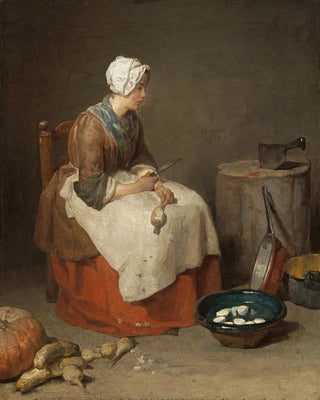Art print | The Maidservant - Jean Siméon Chardin


View from behind

Frame (optional)
At the heart of 18th-century France, a work emerges, capturing the very essence of domestic life with unparalleled delicacy. "La femme de ménage" by Jean Siméon Chardin is much more than a simple depiction of an everyday scene; it is a true ode to simplicity and the beauty of daily gestures. The artist, through his brush, invites us to observe attentively the life of a humble servant, thus revealing the dignity and grace that can be found in the most ordinary occupations. This piece, imbued with realism, transports us to a world where every detail matters, where light plays a key role in highlighting textures and forms. The composition, both sober and refined, encourages us to contemplate the depth of the captured moment.
Style and uniqueness of the work
Chardin stands out for his ability to transform mundane scenes into moments of visual poetry. In "La femme de ménage," the artist uses a palette of warm, earthy colors that evoke an intimate and comforting atmosphere. Shades of brown, beige, and ochre blend harmoniously, creating an ambiance that envelops us. The light, soft and diffuse, illuminates the woman's face, emphasizing her thoughtful expression and concentration on the task at hand. The composition is carefully balanced, with elements arranged to guide the viewer's gaze through the artwork. Every detail, from everyday objects to the folds of the apron, is rendered with precision that testifies to Chardin's exceptional talent. This meticulous attention to detail, combined with a unique artistic sensitivity, makes this work a timeless masterpiece.
The artist and his influence
Jean Siméon Chardin, an emblematic figure of the realist movement, managed to establish himself in an artistic world dominated by rococo and grand historical frescoes. His innovative approach, focused on everyday life and modest subjects, paved the way for many artists who followed his example. Chardin was able to capture the essence of humanity through genre scenes, highlighting the beauty of simple gestures and ordinary objects. His influence extends far beyond

Matte finish

View from behind

Frame (optional)
At the heart of 18th-century France, a work emerges, capturing the very essence of domestic life with unparalleled delicacy. "La femme de ménage" by Jean Siméon Chardin is much more than a simple depiction of an everyday scene; it is a true ode to simplicity and the beauty of daily gestures. The artist, through his brush, invites us to observe attentively the life of a humble servant, thus revealing the dignity and grace that can be found in the most ordinary occupations. This piece, imbued with realism, transports us to a world where every detail matters, where light plays a key role in highlighting textures and forms. The composition, both sober and refined, encourages us to contemplate the depth of the captured moment.
Style and uniqueness of the work
Chardin stands out for his ability to transform mundane scenes into moments of visual poetry. In "La femme de ménage," the artist uses a palette of warm, earthy colors that evoke an intimate and comforting atmosphere. Shades of brown, beige, and ochre blend harmoniously, creating an ambiance that envelops us. The light, soft and diffuse, illuminates the woman's face, emphasizing her thoughtful expression and concentration on the task at hand. The composition is carefully balanced, with elements arranged to guide the viewer's gaze through the artwork. Every detail, from everyday objects to the folds of the apron, is rendered with precision that testifies to Chardin's exceptional talent. This meticulous attention to detail, combined with a unique artistic sensitivity, makes this work a timeless masterpiece.
The artist and his influence
Jean Siméon Chardin, an emblematic figure of the realist movement, managed to establish himself in an artistic world dominated by rococo and grand historical frescoes. His innovative approach, focused on everyday life and modest subjects, paved the way for many artists who followed his example. Chardin was able to capture the essence of humanity through genre scenes, highlighting the beauty of simple gestures and ordinary objects. His influence extends far beyond






